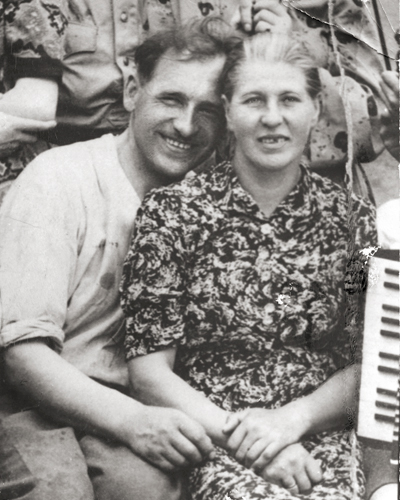
Jonas Paulavicius and his wife Antanina
Once Upon A Time In Panemune
by Lauras Sabonis
(great-grandnephew of Jonas Paulavicius & his wife Antanina Paulaviciai)
— work in progress —
See also: ▸ Jonas Paulavičius by Danutė Selčinskaja
▸ Yad Vashem page for Paulavičius family
▸ Boy with a Violin, a book by Yochanan Fein

Jonas Paulavicius and his wife Antanina
Miriam Krakinowski (née Shumacher) was born on May 22, 1924 in Troskunai, a small shtetl north-east of Kaunas (Kovno, Kovne). Though Troskunai was not a big town, it had a bustling and sizeable Jewish community – according to the 1897 census, out of the 1221 people living there, 779 were Jews. The strong connection of the Jewish community to Troskunai is evidenced by the fact that after they had been sent to exile in central Russia during World War I, most of them returned to Troskunai after the war to rebuild their lives there. There was also a Jewish school, a Jewish library and not just one but two synagogues in Troskunai.
In June 1941, the war came to Lithuania and the Jewish community was not spared the fate of their brethren across the German-occupied territories. Initially, they were harassed and had their homes looted by the Lithuanian collaborators but soon Jewish blood was spilled: fueled by the German anti-Semitic propaganda, some Lithuanians found enough hate in their hearts for their former neighbours to betray and slay them in the Jewish cemetery. The greatest tragedy, however, struck the Jews of Troskunai on August 21, 1941 when all of them who were in town at that time were rounded up, taken to Pajuoste Forest and murdered on August 23 by Einsatzkommando 3a.1
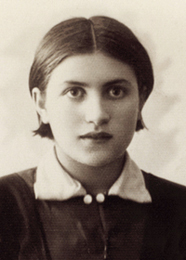
Miriam Shumacher Krakinowski
Fortunately for Miriam, she was not in Troskunai at the time of the German invasion.2 But as she was attending school in Kaunas and staying there, the war caught up with her as well. Miriam was sleeping on a Sunday morning when she was awakened by the terrible roars of a bombing raid the Germans had started over the nearby airport. She had heard that there were supposed to be trains heading eastward to Russia so she quickly headed to the train station to try to leave the city. However, luck was not on Miriam’s side on that day as there were hundreds, if not thousands of other people running and trying to secure a place on the trains for themselves – and in the end, Miriam could not even get close to the train because of the stampede. Almost at the same time, clashes began erupting in the city between the retreating Soviet forces (and communist collaborators as well) and the Lithuanian anti-Soviet activists. As Miriam recalled: “I was frightened, I cried. I ran for my life. Then the town became deadly quiet…” 3
On July 10, 1941, a decree was issued ordering the Jews in Kaunas to relocate by August 15 to a suburb called Slobodka (Vilijampole). On August 15, 1941, the area designated for the ghetto with its 30,000 inhabitants was sealed and cordoned off with barbed wire; in this way, the Kaunas Ghetto came into existence. Miriam recalled that Jews panicked – they had been marched off to the ghetto with only the things they were able to carry themselves – and, furthermore, the Germans and their Lithuanian collaborators took their belongings from them along the way as they pleased. Even once the Jews were inside the ghetto, they were not safe from the marauders as every day there were searches carried out by armed Germans and Lithuanians demanding the Jews turn in their hidden gold, silver or furs. Miriam recalled that once in a while the Germans would shoot one of Jews just to set an example and to repeat that the prisoners should turn over any hidden valuables they might have in order to avoid the same fate.4
Life in the ghetto was a nightmare. Each room of each house in the area was overcrowded with people, and thousands more had to survive living on the streets. As Miriam said, “people didn’t know what to do, how to live.” 5 Food was extremely scarce as well – children, for example, did not receive any rations at all. (Another survivor of the Kaunas ghetto recalled that he and his sister were once given a sandwich by someone and that they cut it into seven pieces and then survived on them for a week.6 ) Miriam realized that the only way to get any food was to go to work with the forced labor gangs, so she lied that she was 18 so as to be included in the workforce and thus have a chance to earn a small piece of bread and some watery soup.7 Miriam had to slave 12 hours every day doing arduous work: “Each morning we’d go out at 6 to rebuild the airport the Germans had destroyed. That was five or six kilometers away. We were not allowed to walk. We had to run. We didn’t dare not to because we were being herded by the Germans with guns.” 8
In November 1943, Miriam and her future husband Morris (Moshe) Krakinowski were transferred from the Kaunas Ghetto, which by now had been re-designated as a concentration camp and re-named KZ Kauen, to the nearby camps of KZ Kaunas-Sanciai (Schanzen) and KZ Kaunas-Aleksotas (Alexoten), respectively, where the men were being used as labour in railroad repair works and the women had been tasked with repairing and recycling uniforms taken from dead or wounded German soldiers. Though Miriam and Morris had casually met in the ghetto, their relationship continued to grow stronger during the months spent in the labour camps as they would sneak out and try to meet for a few moments at a time so not to attract attention from the guards.
In July 1944, as the Eastern Front shifted closer and closer to Kaunas, the Germans decided to move the prisoners out of the work camps around Kaunas (as well as the prisoners in the former Kaunas Ghetto) westward. When the group that Miriam and Morris were in was marching across a bridge over the River Nemunas (Neman, Niemen), they got tangled up with a column of German troops and armoured vehicles moving in the opposite direction. At that moment one of the prisoners decided to make a run for freedom and suddenly jumped over the railing into the river. The German guards quickly rushed to the side and started shooting at him. During this disarray, Morris pushed Miriam down to protect her from any stray bullets hitting her.9 Somehow she got pushed out of the prisoners’ column and onto the sidewalk, but she reacted quickly and got rid of her Jewish badge – and not a moment too soon, because a German guard grabbed her by the neck and was about to shove Miriam back into the line before she started screaming at him in Lithuanian (rather than Yiddish) to let her go. The guard got confused and turned to the prisoners to ask whether they knew her. Everyone denied knowing her, so the guard pushed Miriam down the embankment and the rest of the column marched off without her.10
Unbeknownst to Miriam, the whole ordeal was observed by two people, a man and his son, who were at the time sitting in a boat not far from the bridge. As Miriam got up and started walking away, this is what happened: “I kept walking along the river when I saw a man in a boat with a sack of flour. He called to me in Lithuanian, and I answered his greeting. He asked me if I saw what happened on the bridge, and I told him that I didn’t know. I kept walking. A few minutes later, I heard the man’s voice again behind me. I turned around and asked him why he was following me in his boat. He said that he felt I needed help. I answered firmly that I was in no need of any help and asked him to stop following me. The man told me… that the Germans were checking everyone’s personal documents and I would be caught by them. I told him that I didn’t have any money or jewelry to give him and asked him why he wanted to save me. The man asked me to trust him. I didn’t really trust him, but I had no place to go.” 11
Not really knowing if she had any other options at that time, Miriam decided to accept the man’s offer and followed him to his home. Before entering, the man told her that they had a guest at his house so if he asked her, Miriam had to tell him she had fled from Prienai, a town south of Kaunas. But first he led her down to the basement and told her to wait. Miriam recalled, “I was sure he went to bring the German police to arrest me. I considered running away, but I was too frightened and exhausted. I just sat and waited.” 12 The man returned rather soon and invited Miriam to join him and his family along with their guests at the dinner table. As Miriam had been quite overwhelmed and tired after all the events of the day, she excused herself – so the man took her upstairs instead and told her to lie down and get some rest.
After a while, the man returned to Miriam and led her back to the basement. Next, he moved aside a carpenter’s workbench, took a broom, swept away the wood shavings from the floor and then knocked a few times on the floorboards. A small lid was then opened up from the inside and the man motioned Miriam to step into the hole. As she did so, she realised that below was a small space full of people. Miriam recalled emotionally: “I found myself in a very small, hot room filled with half-naked Jews. I began to cry as they asked questions about the fate of the (Kaunas) ghetto.” 13 Not long after Miriam was rescued, the Germans retreated from Kaunas and when the Soviet soldiers arrived there was no need to continue hiding, so Miriam headed back to Kaunas where she, by a miraculous twist of fate, reunited with Morris (who himself had earlier escaped German captivity) and the two finally married in February 1945 to live a long and prosperous life together.
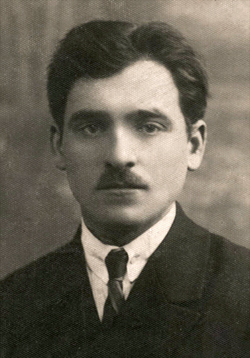
Jonas Paulavičius
The man who had rescued Miriam and the other Jews was Jonas Paulavicius, a Lithuanian carpenter from Panemune (one of the districts of Kaunas). With the help of his wife Antanina, son Kestutis and daughter Danute, he saved 16 people during the war including 12 Jews, two Russian POWs and two Lithuanians. This happened not by chance – Jonas was fully aware of the ruthless punishment he and his family would undoubtedly have faced if they had ever been caught by the Germans, so he took no unnecessary risks. He rented an apartment in another part of Kaunas for his young daughter, whom he loved very much and whose safety he especially feared for, and sent her away to live separate from the rest of the family and the house where the rescued people were hiding, in order to minimise the danger to her life if his actions became known to the authorities.
Jonas Paulavicius had a plan – he wanted to save as many educated and professional Jews as he could, so after the war was over, they could help rebuild a viable Jewish community. He did not develop this plan immediately after the war had started, but when he did, he did so meticulously and carried it out with utmost effort: he and his son built a secret room under his home to house the rescued Jews and fitted it out with double bunks, a radio and a map to track the approximate movement of the frontlines. When the room was finally filled with people whom Jonas had saved from danger, he sold another house he owned in order to be able to feed all of them (and not to forget – his wife had to prepare meals for 20 people every day!) – though Jonas always had to stay vigilant and buy only small amounts of products in one place at a time so as not to raise suspicion. He and his contacts even bribed a Gestapo driver a few times so he would hide a few Jews in a Gestapo officer’s car, drive them out of the ghetto and drop them off at a designated point where Jonas or his son would meet them and take them to the hiding place in his home.
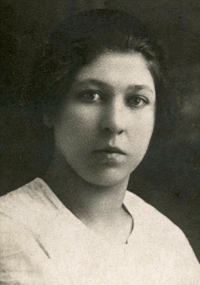
Antanina Paulavičienė
Jonas’s attitude toward the plight of Jews during the Holocaust was only natural, because before the war, apart from some vile anti-Semitic individuals, Lithuanian and Jewish communities had been living in harmony and there was plenty of mutual respect and friendship between the two, Jonas’s niece Aldona recalls – she relocated to Kaunas with her parents in the late 1930s but the family was originally from Anyksciai (Anyksht), a small town north of Kaunas (and only 20 km from Troskunai), where Jews accounted for about one half of the 4,000 people who used to live there before the war. According to Jonas’s son Kestutis,14 Anyksciai was a popular destination among Jews from nearby towns – they used to come there often and also have soccer matches with the local “Maccabi” team. Jewish traders and shopkeepers had always been willing to agree to a bargain even if the initial price was high, and if the buyer did not have enough money on hand, they were ready to offer credit and the customers were able to repay it after receiving their salaries. Many Lithuanian and Jewish families were living door-to-door for generations, maintaining good relationships.
That was also the case of the Paulaviciai family and the Fein family, who owned a local flour mill. Kestutis recalls that his father Jonas, who worked as a carpenter at the Lithuanian Railroad company, used to help out Menachem, the head of the Fein family, at his mill regularly.15 Kestutis himself and Fein’s younger son Yochanan (Jochanan) were friends and went to the same school.
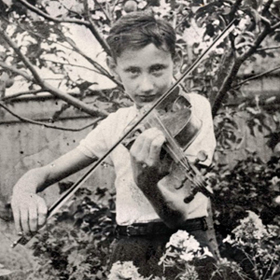
Yochanan Fein
As the war front came to Kaunas in 1941, Jonas was arrested by the Lithuanian Nazi-collaborators and incarcerated because he was a chairman of the local labor union at the railroad company. But since it was not considered a serious crime even by the German standards, he was soon released and returned to his home in Panemune. Sadly, Menachem Fein did not have the same luck, and he and his older son, Tzvi (Zevi), were shot to death by Lithuanian collaborators during the first days of German occupation. The rest of the Fein family was later herded to the ghetto in Slobodka. The details have been erased by the many years that have passed, but at some point during the later years of the occupation, Kestutis met with Yochanan outside the ghetto and took him home, where he then lived with the Paulaviciai family in relatively broad daylight because, according to Kestutis, Yochanan’s appearance did not have characteristic Jewish features so there was no need for the boy to hide somewhere far out of sight.16 Yochanan became a full-fledged family member, even with his own new name – ‘Juozas’, as the Paulaviciai family used to call him (which is Lithuanian for ‘Yosef’), spending his time with Kestutis learning to play chess from him and also practicing violin.
However, at the end of the German occupation, and much to Yochanan’s surprise, he found out that he was not the first person to have been taken in by the Paulaviciai family. It all began with Ceslovas Prapuolenis (originally from Kybartai), who was a friend and a colleague of Jonas, being approached by Yitzhak and Lena Shames (originally from Kybartai as well), prisoners in the Kaunas ghetto at the time, with a plea to save their four-year old son, Shimele (also known as Simonas). Fearing for his life, the Shameses asked Prapuolenis to take in the boy – but as Prapuolenis was afraid for his own family’s sake in case they were to be discovered sheltering a Jewish child, he instead turned to Jonas for help. After consulting with his wife Antanina, Jonas agreed to accommodate Shimele, who was then smuggled out of the ghetto and brought to Panemune.
Soon after that, the Paulaviciai family arrived at the turning point of what would be their journey rescuing Jews. As Shimele was very young, he used to cry a lot and also had a habit of wandering outside the house if left alone (where obviously someone could have noticed him and reported it to the German authorities). Once he even set fire to a wall while playing by the fireplace – fortunately, Kestutis was around the house at the time and managed to extinguish the flames before they got out of control. Because of all this little Shimele needed to be watched constantly and before long, Jonas and Antanina decided that it would be best if Shimele’s parents came to stay with them as well. After hearing the proposal, Lena Shames begged for the Paulaviciai to also rescue her aged mother (last name Feinsilver), which they agreed to do – so after escaping the ghetto, there were four members of the Shames family in the Paulaviciai household.
It was then (or just before taking in Yitzhak and Lena with her mother) that Jonas decided he would build a secret shelter under his house where Jews could hide safely and wait for the war to end. In addition, Jonas decided to make the compartment big enough to house even more persons because, as mentioned earlier, his idea was to try and rescue as many professionals as he could accommodate – doctors, engineers, intellectuals – people who would be able to greatly contribute to rebuilding the Jewish community that was being viciously destroyed by the Germans and their local henchmen.
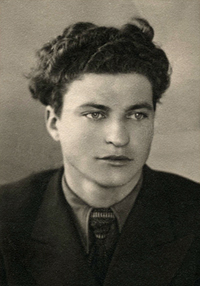
Kęstutis Paulavičius
The first thing Jonas did was dig out a pit under the basement of his home with the help of Kestutis (then aged 15). It took them a few nights to complete the task, as they did not want to attract any unnecessary attention, and they dumped the soil they had removed in a few different places around the property. Jonas and Kestutis then reinforced the walls of the freshly-dug cavity with wooden structures (while the foundation of the house served a double purpose as a ceiling) and installed double bunk-bends inside the compartment – needless to say, all this was not difficult work for a skilled carpenter like Jonas. The shelter had two entrances – one led inside the basement and had a wooden hatch installed over it and the other one led outside, behind the house and was camouflaged with wooden planks so no one would be able to notice it. The one behind the house served as a ventilation outlet, and people hiding inside the shelter also used it to exit during night-time to get fresh air. The entrance that led to the basement usually had the lid closed over it (though sometimes it was left open for ventilation purposes too), camouflaged with wood shavings left over from carpentry work and also had Jonas’s workbench moved on top of it as well.
In the meantime, Jonas asked the Shameses to find other Jewish professionals he could take in to the shelter he was building. Yitzhak went to his friends, the physicians Drs. Chaim and Tania Ipp (née Chaimovich) and told them about Jonas’s plan. At first Chaim was skeptical because he knew he didn’t have anything to give in return, and he didn’t believe anyone would be willing to risk their own life to rescue Jews from the ghetto and shelter them at their home. However, after Yitzhak arranged a meeting outside the ghetto for Jonas and Chaim, he changed his mind. His wife Tania later shared her impressions about Paulavicius: “Jonas proved to be an extraordinary person, a rare breed: an extremely pure, honest and fearless man. He conscientiously jeopardized himself and his family. For us he was a real father and a personality to admire.” 17
This is not an overstatement – Jonas and his family took care of the people they had rescued as their own kin. Jonas would spend as much time as possible with those hidden – especially at night, when he was back home from work or buying supplies. He set up a radio inside the hiding place as well as a map to track the movements of the Red Army so everyone would tune in to the latest dispatches from the front and mark the locations that were slowly but surely getting closer to Lithuania on that map. When Jonas went to buy supplies for the whole extended “family”, he traveled large distances around the area to procure food so as not to arouse suspicion as to why he would be looking for such huge quantities of flour, peas and bacon flitch when their home was officially only housing the three Paulaviciai members. To raise money to be able to feed the extra people they were hiding, Jonas sold another house he owned in Birute village (another district of Kaunas). He also managed to get his hands on some valuable items a few times – some military trench coats and once even a hunting rifle – which, according to Kestutis, his father traded for a hefty amount of bacon flitch.

Jonas and Antanina
No less impressive is the way in which Jonas smuggled some of the Jews out of the Kaunas ghetto to his home. Not all the details have survived in the decades that followed, but this much is clear – Jonas and his friends who had been helping the Jews escape the captivity found a Lithuanian man who had worked as a driver for the Gestapo and bribed him to hide the people bound for freedom in the car he was driving in and out of the ghetto. He then would leave the ghetto with the secret passengers, take them to a pre-arranged place and drop them off. After that, Jonas or Kestutis would meet the newly-liberated Jews and lead them via back roads to the Paulaviciai home in Panemune.18
A different method was used by Jonas to rescue Musia (Manya) Neimark (later Gershenman), who was the wife of an engineer named Aron (Aaron) Neimark – as the Neimarks were suggested by the Shameses as another prospective candidate that the Paulaviciai could take in, their rescue happened right after the Ipps were brought in. It is not clear how exactly her husband had been taken to Panemune, but Musia herself was met by Jonas outside the ghetto and they then had to walk 15 kilometers to the Paulaviciai house. As Musia was afraid that she could be noticed because of her distinctive Jewish looks and caught by the Germans, Jonas told her to follow him at a certain distance when walking through Kaunas and they agreed that if she happened to be arrested, Jonas would not stop and continue home without her, because he could not risk being arrested as well with so many people at home dependent on him. Luckily for both Musia and Jonas, the journey was completed without any problems.19
When the Germans retreated from Kaunas and the Soviets came to Panemune, Jonas joyfully announced the news – the Jews then slipped out of the shelter in the ground that had served as their home for so long and came to the yard, to be met by dumb-struck Red Army soldiers. According to Musia, “When they saw us exiting through the narrow opening, dirty, half-naked, deathly pale, disheveled, and very thin, they withdrew and stood at a distance from us. They were shocked by the sight in front of them, and stood open-mouthed.” 20 But the Jews did not mind that at all because they were free at last and so thrilled because of this. A surprise was awaiting them – when everyone came to the house for a celebratory dinner, they were amazed to meet a few other Jews (among them David Rubin and Riva Katavushnik), two Russian POWs and two Lithuanians who were wanted by the Germans authorities. The Paulaviciai hid all those people either inside their house or in another smaller shelter nearby.
Jonas’s niece recollects that throughout the war neither Jonas, nor the other family members, ever mentioned that the Paulaviciai were sheltering people from the ghetto in their home – when she used to visit Panemune, she never had any idea. During one visit, she wanted to go upstairs to see the second floor, but Kestutis jokingly but firmly stood in her way and she had to desist.21 Only after the Germans had left Kaunas did she find out that it was Yochanan who was hiding upstairs at that time and whom the Paulaviciai were protecting from being discovered by anyone but them.
The moment when the Paulaviciai plan was closest to derailing occurred when there was a Russian POW on the run who had escaped the prison camp and who was chased by the Germans. He ran by the Paulaviciai house and disappeared in the woods nearby. One of the German soldiers demanded that Kestutis’s cousin, who was visiting the family at that time, tell him where the man had gone. The cousin pointed in the opposite direction but the soldier barged into the house to make sure that the POW had not been hiding somewhere inside. Kestutis recalled that the moment when the German burst into the basement his heart stopped for a second because he was not certain whether the cover of the shelter had been closed or not. The only thing that was on Kestutis’s mind at that moment was the thought that he should probably get ready to grab the soldier by the neck and shove him down to the hole where everyone could then partake in knocking the German unconscious.22 Fortunately, the lid was actually closed and well concealed so the Paulaviciai secret, and the Jews that were part of it, remained safe.
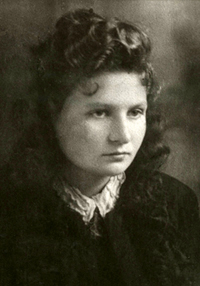
Danutė Paulavičiutė
Jonas Paulavicius, his wife Antanina Paulaviciene, his son Kestutis Paulavicius and his daughter Danute Paulaviciute are heroes to many people, but they never viewed themselves as such. They saved people who were suffering, not because of their own religious beliefs and not because they were after any personal gains. The Paulaviciai did it because it was the right thing to do. They did not view the Jews they had been sheltering as different or foreign to themselves – they were just people whose lives had been in danger and it was the conscientious wish of the Paulaviciai family to try and save them, even if it meant risking their own lives doing it.
It is fair to say that the wish of Jonas Paulavicius to get the Jewish community rebuilt did in fact come true over the long years after the war, even though all of the Jews he had rescued eventually left Kaunas for Israel, South Africa, and the United States. Sadly, Jonas himself was not granted the right to live long enough to witness it with his own eyes. On one summer night in 1952, a single shot came in through the open window of his bedroom and killed Jonas in his sleep. Some say Jonas was murdered by someone who hated him deeply for saving the Jews, but as the killer’s identity was never discovered, the real motives weren’t either. A few years before his death, another tragedy had struck Jonas – his beloved daughter Danute died of tuberculosis. The only remaining members of the Paulaviciai family, Antanina and Kestutis, continued with their humble lives in Panemune, eventually regaining contact with some of the people they had rescued after the Soviet authorities lifted the ban on corresponding with Western countries. Kestutis, though recovering from a stroke, is still living in Panemune with Janina, his wife of 60 years, in 2014.
There is no better way to close this text than with the words of David Rubin, one of the rescued Jews, that he proclaimed in 1984 at Yad Vashem, when the Paulaviciai family were declared “Righteous Among the Nations”:
Jonas, dearest of all men… You lived and grew up among the Lithuanian people, many of whose sons participated in the murder of our people, and most of whom remained indifferent to our fate… We promise to keep in our hearts forever your memory, and teach our children to cherish your memory with love and respect. You knew much suffering in your life. You lost your sole daughter whom you loved much. At the end, evil hands put an end to your life. I was not there when the murderous hand was lifted on you; my ears did not hear your pain’s cries. My heart is broken from much pain… Allow us to recall the admiration of your rescued persons. May your soul be eternally alive.23
Lauras Sabonis
Vilnius, 2014
UPDATE: Defending History named Jonas Paulavičius (1898–1952) as Person of the Year for 2019.
Footnotes